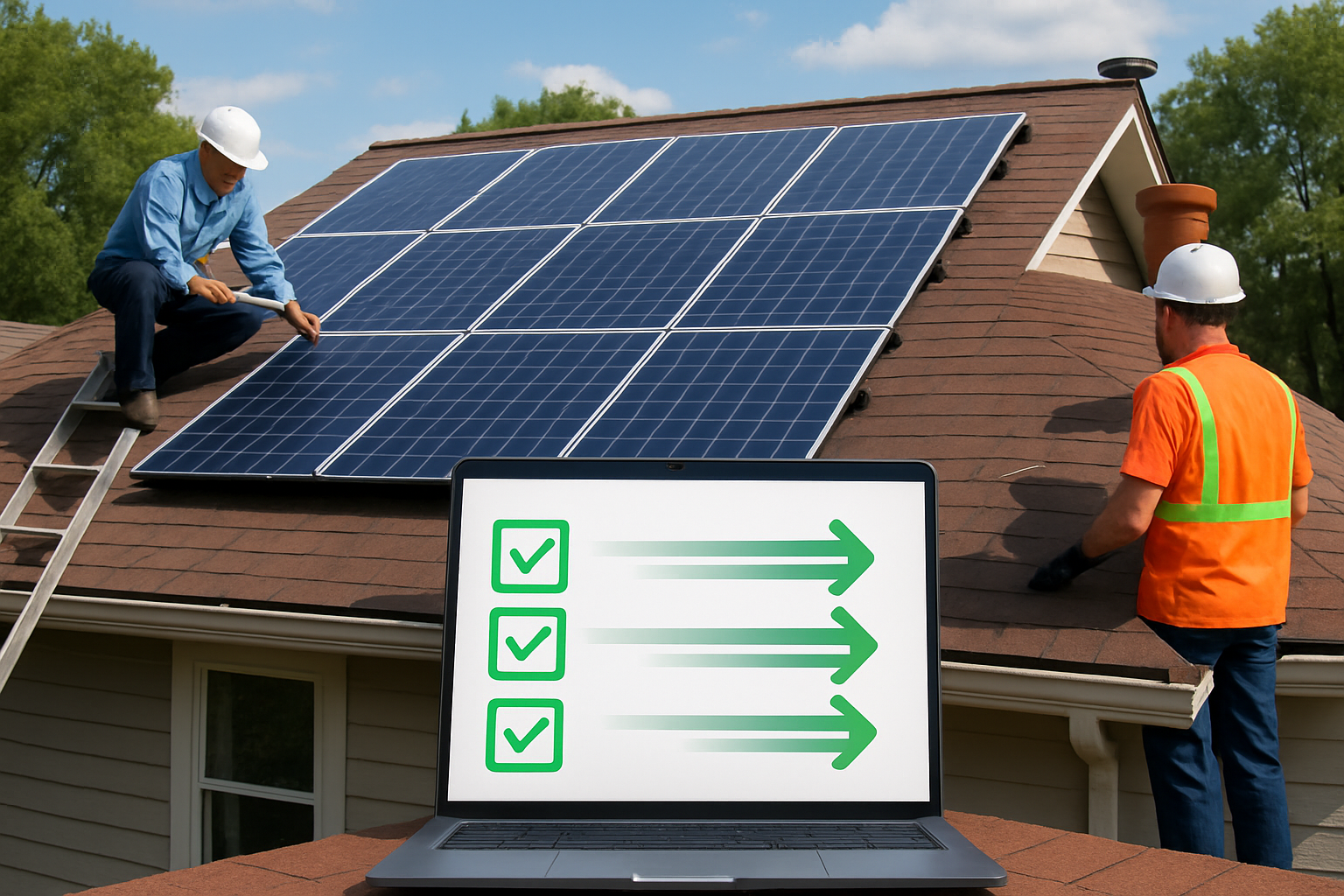The solar and energy storage industries are transforming how we power our lives. As this shift accelerates, understanding the intricate web of permits, building codes, and interconnection standards becomes increasingly important. For 2025, these regulations are evolving, presenting both opportunities and complexities. Navigating this landscape effectively ensures your projects are safe, compliant, and contribute to a resilient energy future.

The Evolving Landscape of Solar Permitting in 2025
The regulatory environment for solar energy is dynamic. Federal and state policies are continually updated to support renewable energy adoption while maintaining safety and grid stability. Staying informed about these changes is crucial for successful project deployment.
Federal and State Policy Shifts
Federal actions significantly influence the renewable energy sector. For instance, projects on federal land or those requiring federal permits are now subject to an “elevated review” by the US Department of Interior. This could introduce delays and uncertainty for some developments . Additionally, some Clean Water Act permitting related to wetland impacts for renewable energy projects faced temporary pauses in early 2025 .
Conversely, many states are actively streamlining their processes. Florida, for example, enacted new legislation in 2025 to make rooftop solar permitting faster and simpler. This includes allowing private providers, virtual inspections, and automated permitting platforms. The law also prohibits local governments from requiring unnecessary documents, which often create bottlenecks . California's 2025 Energy Code (Title 24) brings significant changes, mandating solar and energy storage for new construction, including single-family homes, multifamily units, and specific non-residential properties. These updates aim to enhance onsite clean energy use and reduce reliance on the electrical grid .
Digital Transformation in Permitting
The push for efficiency has led to a greater adoption of digital tools and automated platforms in the permitting process. These systems standardize procedures, reduce paperwork, and can significantly cut down approval times. For instance, Florida's new law explicitly allows the use of automated permitting software . Such digital solutions help navigate the varying approaches of states, counties, and municipalities, some of which have embraced solar while others have adopted more restrictive stances .
Navigating Building Codes for Solar and Storage Safety
Building codes ensure the safety and longevity of solar and energy storage installations. These codes cover everything from structural integrity to electrical and fire safety, requiring meticulous attention to detail.
Roof Safety and Structural Integrity
Rooftop-mounted photovoltaic (PV) panel systems and solar thermal collectors must be designed with robust wind resistance, adhering to standards like Section 1609 of the California Building Code . For many installations, especially on tile and commercial buildings, a structural engineer's evaluation of the roof is a critical requirement. This assessment confirms the roof can safely support the additional weight and wind load of the solar system .
Electrical and Fire Safety Standards
Electrical permits are essential for all energy storage system (ESS) installations. These require detailed submissions such as electrical diagrams and equipment specifications. Installations must comply with local electrical codes and national standards, including Article 690 of the National Electrical Code (NEC) . For lithium-ion outdoor systems, specific construction permits and site-specific material acceptance are often required, alongside compliance with local construction and fire codes . Fire safety regulations, including rapid shutdown requirements and proper labeling, are paramount to ensure the safety of occupants and emergency responders. The 2020 updated Energy Storage Permitting and Interconnection Process Guide for New York City, for example, outlines detailed requirements for outdoor lithium-ion based ESS, developed in collaboration with local authorities .
Interconnection Standards and Grid Integration
Connecting solar and storage systems to the electrical grid involves adhering to specific interconnection standards. These standards are vital for maintaining grid stability and reliability, especially as more renewable energy sources come online.
Connecting to the Grid
Interconnection standards define the procedures for how a distributed generation system, such as solar PV, connects to the grid . Inconsistent or overly complex interconnection processes can cause significant delays and increase project costs, posing barriers to development . Organizations like the Interstate Renewable Energy Council (IREC) provide resources and model procedures to improve these processes . The Federal Energy Regulatory Commission (FERC) is also pushing for reforms to reduce red tape and integrate renewable energy faster, shifting from a “first in, first out” model to a “first ready, first served” format for interconnection requests .
The Role of Energy Storage in Grid Stability
Energy storage systems (ESS) are increasingly recognized as a key component for grid stability, particularly with the rising penetration of variable renewable energy. Utilities may impose stricter interconnection standards or require energy storage as part of solar installations to manage energy supply fluctuations . For example, the IRENA Malaysia energy transition outlook highlights plans to install five units of 100 MW battery energy storage systems annually from 2030 to 2034 to address system stability concerns due to the influx of renewable energy . The IEA's analysis on Enhancing Indonesia’s Power System notes that existing assets in Java-Bali and Sumatra could accommodate a 10% share of solar electricity by 2025 using existing flexibility, without requiring additional grid or storage capacity investments, though contractual inflexibility can lead to curtailment . Our company's integrated ESS solutions, combining lithium batteries, hybrid inverters, and solar panels, are designed to provide reliable and scalable energy, supporting both individual energy independence and broader grid resilience.
Table: Key Regional Renewable Energy Targets for 2025
| Region/Country | 2025 Renewable Energy Target | Source |
|---|---|---|
| Malaysia | 31% of total installed capacity | IRENA Malaysia Energy Transition Outlook |
| Indonesia | 23% share in electricity mix | IEA Enhancing Indonesia's Power System |
| California (New Construction) | Mandatory solar and battery storage | California 2025 Energy Code (Title 24) |
Strategies for Efficient Compliance and Project Success
Navigating the complex regulatory landscape requires a strategic approach. Focusing on meticulous planning, thorough documentation, and leveraging available expertise can significantly streamline your solar and storage projects.
Proactive Planning and Documentation
Successful permit submittals begin with comprehensive planning. You need to prepare a detailed site plan showing the location of meters and disconnects, along with a construction plan that includes manufacturer cut-sheets for all components such as roof mounting systems, inverters, and solar panels . Meticulous documentation helps avoid costly delays and ensures your project aligns with all local and national requirements. The National Simplified Residential PV and Energy Storage Permit Guidelines offer a step-by-step checklist for electrical and structural requirements, helping local governments and contractors align for a smoother process .
Leveraging Expertise and Technology
Partnering with experienced solar and energy storage professionals who understand the latest codes and permitting nuances is invaluable. These experts can help optimize project structures, navigate regulatory changes, and ensure compliance. Utilizing digital permitting tools can further expedite the process, reducing administrative burdens and improving communication with authorities. Many jurisdictions are working to adopt standardized, streamlined procedures for energy storage installations, with guidebooks being developed to identify best practices .
Disclaimer: This article provides general information and does not constitute legal, financial, or engineering advice. Always consult with qualified professionals for specific project requirements and regulatory compliance.
A Forward Look at Solar and Storage
The solar and energy storage industries are on a clear path of growth and innovation. While 2025 brings new regulatory challenges, it also presents opportunities for those prepared to adapt. The emphasis on robust permitting, adherence to evolving building codes, and seamless grid interconnection ensures that these technologies can deliver reliable, scalable energy solutions. By staying informed and embracing best practices, you contribute to a future of greater energy independence and a more resilient power infrastructure.
Frequently Asked Questions
Do solar installations always require permits?
Yes, permits are almost always necessary for safety, compliance, and proper grid integration. This applies to both solar PV and battery storage systems. Local authorities having jurisdiction (AHJs) review plans to ensure adherence to building, electrical, and fire codes.
How are interconnection standards changing for 2025?
Interconnection standards are evolving to support grid stability with increased renewable energy penetration. Expect stricter requirements, potentially including real-time monitoring capabilities and active grid support functions for systems. Utilities are increasingly focused on managing energy supply fluctuations effectively .
What is the impact of energy storage on permitting?
Energy storage systems (ESS) often have specific permitting requirements beyond those for solar PV alone. This includes separate electrical and construction permits, and often requires site-specific material acceptance. Jurisdictions are increasingly integrating ESS into their building codes, reflecting their growing importance in energy systems .
What are the key building code updates for solar in 2025?
Many jurisdictions, such as California with its 2025 Energy Code (Title 24), are updating codes to mandate solar and energy storage for new construction, including single-family homes and commercial buildings. These updates aim to enhance onsite clean energy use, improve energy efficiency, and reduce reliance on the electrical grid .





Leave a comment
All comments are moderated before being published.
This site is protected by hCaptcha and the hCaptcha Privacy Policy and Terms of Service apply.